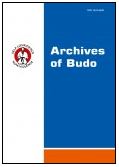2017, Volume 13
Gender differences in strength lateral asymmetries, limbs morphology and body composition in adolescent judo athletes
Lucia Mala1, Tomas Maly1, Rafał Camirelli2, Marcin Dornowski3, Frantisek Zahalka1, Miroslav Petr4, Pavel Hrasky1, David Bujnovský4
1Faculty of Physical Education and Sport, Charles University in Prague, Prague, Czech Republic
2Faculty of Tourism and Recreation, Gdansk University of Physical Education and Sport, Gdansk, Poland
3Faculty of Physical Education, Gdansk University of Physical Education and Sport, Gdansk, Poland
4Faculty of Physical Education and Sport, Charles University in Prague, Prague, Poland
Author for correspondence: Lucia Mala; Faculty of Physical Education and Sport, Charles University in Prague, Prague, Czech Republic; email: lucilali[at]yahoo.de
Full text
Abstract
Background and Study Aim: Maladaptive changes and asymmetries represent a high risk of adolescent injury in judo practice. Another health risk in judo is the manipulation of body weight to compete in the tactically most advantageous weight category. The aim of the study was the gender differences in body composition, upper limb muscle strength, upper and lower limb morphology in adolescent judo athletes.
Material and Methods: Fifty-nine judo athletes participated in the study (39 boys and 20 girls); all were members of the Czech adolescent judo teams. Using multi-frequency bio-impedance analysis, we monitored body height, body mass, body mass index, lean body mass, relative lean body mass, percentage of fat mass, bone mass, protein mass, total body water, segmental proportion of muscle mass, fat mass, phase angle and percentage differences between the upper and lower extremities. Muscle strength was measured using a calibrated hand dynamometer.
Results: The difference in the percentage of fat mass between boys and girls was significant (boys: 17.27 ±5.02%, girls: 23.38 ±4.28%, F = 22.48, p = 0.00, d = 1.31). The boys had a significantly higher proportion of muscle mass in upper and lower limbs compared with the girls (p<0.01). Bilateral comparison of muscle mass proportion in the preferred and non-preferred limb in the group of boys showed a significant proportion of muscle mass in the preferred upper and lower limb (p<0.01). Gender did not have any significant effect on the size of the phase angle between the compared limbs (p˃0.05). In the non-dominant limb, we detected a significant correlation between the phase angle and the level of muscle strength (boys: r = 0.64, p<0.01, girls: r = 0.61, p<0.01).
Conclusions: To reduce the risk of injury and negative impacts on the health of adolescent athletes, it is important to continuously monitor and correct optimal body composition concerning the targeted weight category of each athlete and the symmetrical proportion of active mass in particular segments.
Key words: lean body mass, maladaptation, muscle mass, muscle strength




